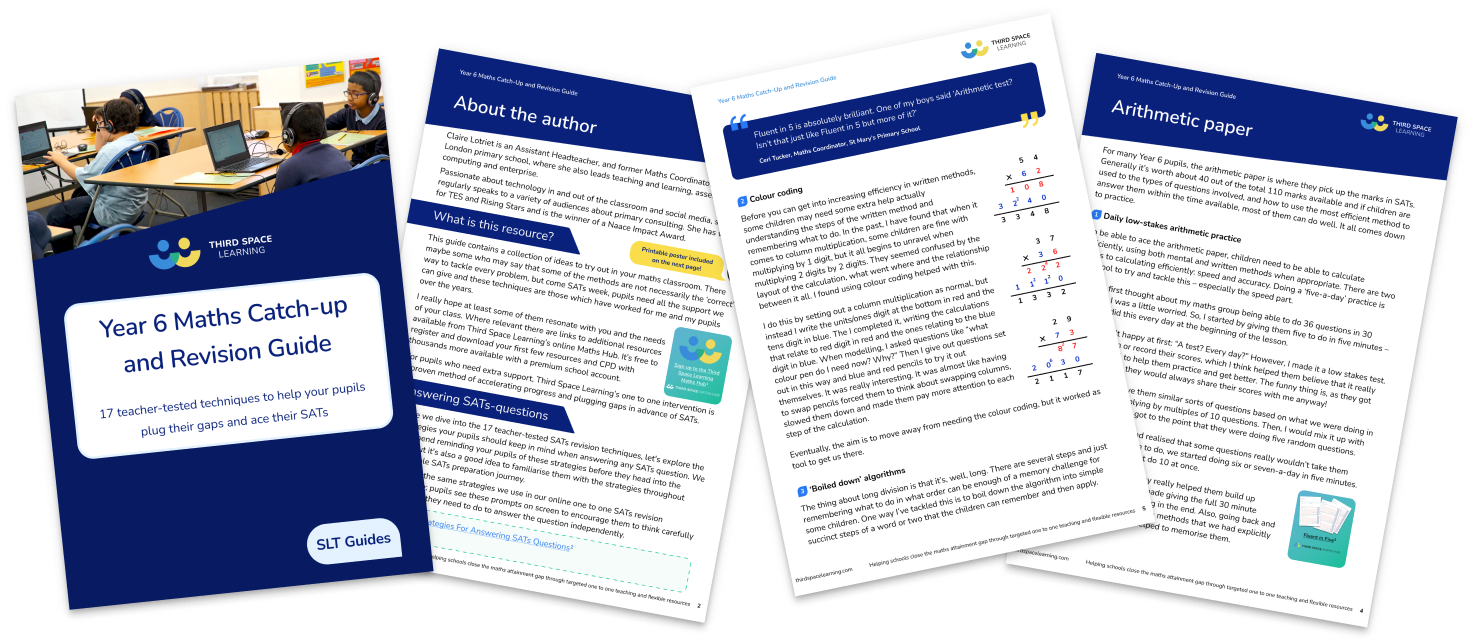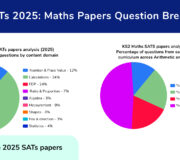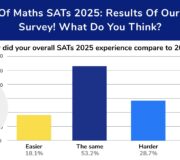15 insights from the KS2 SATs Papers 2016 (Mathematics)
Originally published on 4th January 2017.
In an ideal world, we would all be studying the 2016 Question Level Analysis available from RAISEonline data to glean the insights we need about what we need to teach and cover in our Year 6 SATs revision.
This QLA is the first to report on the new KS2 SATs in 2016 national curriculum assessments and is full of insights around the SATs questions pupils struggle with and the ones they find easier.
However, if you’re like most teachers, Maths coordinators and SLT, an evening spent poring over the details is probably not at the top of your to-do list right now.
So we’ve done it for you, and what we’ve learnt about the maths SATs papers may surprise you.
Year 6 Maths Catch-up and Revision Guide
Get 17 teacher-tested techniques to help your pupils ace their KS2 SATs. Provides a friendly, approachable style with proven success.
Download Free Now!Background to the RAISEonline QLA
2016 RAISEonline outlines the questions in the 2016 SATs which were answered well, the ones which were answered poorly and the ones which weren’t even attempted by some of the nation’s 10 and 11 year olds. The document also breaks this information down into some basic groups such as boys, girls, children with special educational needs and children eligible for free school meals.
It’s a resource with great potential but it takes some analysis to understand its potential in directing your Year 6 SATs revision for 2023.

Unlimited primary maths tutoring with Skye, the voice-based AI maths tutor.
Built on the same principles, pedagogy and curriculum as our traditional tutoring, but with more flexibility, reach and lower cost.
Join the schools already helping hundreds of primary pupils nationwide with Skye’s one to one maths tutoring.
Watch Skye in actionKS2 SATs Maths Reasoning Papers 2016: Where to focus your Year 6 SATs revision
Let’s start with the two reasoning tests; they account for 70 out of 110 marks. Both papers contain questions relating to Key Stage 2 curriculum objectives, ranging from content from the Year 3 curriculum to objectives taught mainly in Year 6.
Reasoning insight 1: Only 13 questions on each KS2 Sats reasoning paper were based on Year 6 content so don’t lose sight of your practice of previous years’ work too
The majority of these questions were found in the second half of the test (although it is worth noting that the questions are not strictly sequenced in order of year group content and therefore it is not necessarily the case that each question is more difficult than its predecessor).
The interesting bit comes from looking at how pupils perform ‘on average’. The data shows that twelve of the thirteen questions (split between the two tests) were answered incorrectly by more than 50% of children. This is despite the fact that over 90% of children had attempted these ‘difficult’ twelve questions so a large proportion had a go but didn’t succeed.
By cross-referencing the QLA data with the breakdown of content domain coverage for each question (found in the mark scheme), as well as with the test framework document (which gives more information on each content domain strand and sub-strands) some patterns begin to emerge.
A key theme is that to succeed in KS2 SATs, Year 6 SATs revision only is not enough and therefore maths interventions should not start in Year 6.
Reasoning insight 2: Problem solving is a key issue to address in preparing for the KS2 SATs tests
Four of the twelve most poorly answered questions in last year’s Maths tests mention the words ‘solve problems’ from these sub-strands (Paper 2 Q18, Paper 2 Q19, Paper 3 Q20, Paper 3 Q21). Problem solving has been high on the agenda since the curriculum was introduced but it is worth remembering that children taking last year’s tests had not been taught the new curriculum for the entirety of Key Stage 2, let alone during their whole time at school.
Of the ‘solve problems’ questions that were answered poorly three of them were at year 6 level, the other at year 5 level. The tests contained six other ‘solve problems’ questions only one of which was year 6 level – between 50 and 70% of children got those questions correct – this could be considered as fairly low given that most of the questions were not pitched at a year 6 level.
So it would seem that ‘problem solving’ is a key issue to address this year in readiness for the tests. If you’re on the hunt for problem solving strategies, download our Maths SATS revision pack for a free lesson’s worth of ideas and strategies to help with Year 6 SATs revision and recall. You may also wish to check out our Year 6 SATs practice papers available as free downloads.
Reasoning insight 3: The four most poorly answered problem solving questions require a child to be able to manipulate several key mathematical facts and strategies at a time
For example, question 18 from Paper 2 requires a child to be able to half numbers, use the inverse operation, work with decimals and have a secure understanding of place value – it’s the sort of question that to a child looks almost impossible to answer! We definitely need to work on children’s fluency here and build knowledge of their number facts here!
Reasoning insight 4: Another of the problem solving questions required children to give a written explanation, in other words to reason in writing
How confident are you pupils at doing this? They’ll need practice for this year! In some of the most difficult questions, the curriculum’s three main aims are central – the tests appear to be designed carefully to assess these skills.
Reasoning insight 5: As part of your YEar 6 SATs REvision in 2016 Make sure Children must have the ability to read and understand written questions in order to be able to answer them
Two of the ‘problem solving’ questions are incredibly wordy. It has been said that over the years the tests have gradually relied less and less on vocabulary-heavy questions, but it is inevitable that some questions remain where reading skills are vital, such as perhaps the two most wordy questions in the test (Paper 2 Q19 & Paper 3 Q20).
Some of the other most poorly answered questions are also quite text-heavy (Paper 2 Q20 & Paper 3 Q9). As much as anything your children need resilience to keep on with these wordy questions.
Reasoning insight 6: We should ensure that children are confident in using measures fluently across the curriculum, and also introduce more context to Maths problems
The same two ‘problem solving questions’ (Paper 2 Q19 & Paper 3 Q20) were both multistep problems involving money (as well as fractions, proportions and mass – that fluency again). Two of the other most incorrectly answered questions (Paper 2 Q15 & Paper 3 Q9) involve time and temperature. The connection? All real-life applications of Maths, all from the measurement domain. Could it be, for whatever reason (perhaps the preparation for the context-devoid Arithmetic test?), that teachers placed less emphasis on those day-to-day uses of Maths?
And more questions were answered poorly that fall under the measurements banner: one example is Question 17 on Paper 3 asks the children to find areas of triangles using the squares on the grid – what is really quite a simple question became a stumbling block for many. In past SATs papers, there have been many questions requiring children to find area using the squares but this is the first time (that I can recall) that it has been triangles.
Reasoning insight 7: Triangles and polygons came up a lot and stumped a lot of pupils
Traditionally teachers have spent less time on geometry in Year 6 but the message from last year’s test results is that we need to focus on it more. Four of the most poorly answered questions involve triangles and other polygons: Question 20 on Paper 2 involves some tricky coordinates work, Question 17 on Paper 2 requires children to find missing angles in a slightly complicated diagram and Question 18 on Paper 3 also relates to angles and shapes.
Reasoning insight 8: Multi-step mental Maths problems are perplexing to many children
We must find new and innovative ways to visually present Maths to our pupils so they are prepared for these (and for real life!). I’m always in awe at the new ways the test writers find to present questions. Question 4 on Paper 3 (a year 6 level question but parked right up at the front of the test) perplexed many children last year. It required four (individually simple) mathematical steps to be taken mentally and my guess is that most incorrect answers were because not all of the four steps were taken.
It’s actually not dissimilar to the sort of Maths puzzle that go viral on the internet. We can’t expect to show pupils everything but by exposing them to a greater variety of question types we will encourage their ability to apply all different skills and strategies.
Reasoning insight 9: Numbers up to 10 million is clearly stated in the curriculum and it was in the KS2 SATs test
The last of our twelve questions (Paper 3 Q19), another centred on secure place value knowledge and multiplication, is worth a mention for the fact that it involves large numbers, more specifically: a million. Do ensure that in everything you do children are given opportunities to work with numbers of this size.
Reasoning insight 10: Pupils need stamina and practice to do their best in the National assessments
75% of the most poorly-answered questions (the ones we’ve focused on here) were the last 4 or 5 questions of each test. These last questions were mostly the ones that tested Year 6 level objectives so they were bound to be more difficult.
However, it is also highly possible that despite the level of difficulty these questions were poorly answered simply because they were at the end of the test.
The final message from the analysis of these questions is that children need to work quickly and efficiently enough to reach the end of the test with enough time and energy to answer the last questions accurately. This is where training children in SATs test skills comes into play, rather than just Mathematical skills.
KS2 SATs Maths Arithmetic Paper 2016: Where to focus your Year 6 SATs revision
With only one Arithmetic paper worth 40 marks, it’s a more straightforward picture. There are actually only 4 questions that were answered incorrectly by more than 50% of children. There are a further 7 questions that were answered incorrectly by between 30% and 50% of children which we will also analyse. Encouragingly this means that 25 of the questions were answered correctly by 70-or-more percent of the nation’s year 6 children.
Arithmetic insight 1: Multi-step SATs questions using fractions and decimals are tripping children up, even where they’ve mastered the more simple fractions questions
Unsurprisingly the biggest group of questions that were answered incorrectly all involved the use of fractions or decimals. 7 out of our 11 questions to be precise. Because the arithmetic test deals with calculations, all of these fractions/decimals questions involve either addition, subtraction, division or multiplication and whilst some simple questions involving calculations with fractions were answered well (e.g. Q24) it is clear that in preparation for this year’s tests much work must be done on calculating with fractions and decimals, particularly where the questions involve more than one step.
Arithmetic insight 2: We need to give pupils practice dividing by higher two digit numbers
Questions 28 and 32 (both towards the end of the test) are questions involving the division of numbers of up to 4 digits by a two digit whole number, neither of which produced a remainder. The two digit numbers in question were 29 and 43 – a key message here is that when setting practice questions teachers must not stick to low two digit numbers.
Arithmetic insight 3: The order of operations is still a struggle for some children to remember
The last question on the test required the children to have good knowledge of the order of operations in order to carry out a calculation involving subtraction and division (60 – 42 ÷ 6 =). 45% of children got this question wrong highlighting this as an area for increased practice during the next few months.
Arithmetic insight 4: Fluency is key and should be developed through a variety of question styles
Question 29 required the children to find 15% of 440 but many children were clearly caught off-guard by the presentation of the question: 15% × 440 =. This way of asking the percentage (which had not been seen on the sample material) tested the children’s fluency skills and unfortunately many did not feel confident enough to be able to answer this question correctly.
Arithmetic insight 5: Stamina – again
Even by the end of the Arithmetic test, children appear less likely to answer a question, and have even less chance of getting it correct. This is about speed and stamina. Practice KS2 SATs Arithmetic papers can help on this, as can work to support children understanding which questions to answer with a written and which with a mental method.
Year 6 SATs revision sorted
Now it’s over to you. I hope you’ve got a few nuggets here from this first year of the new reasoning and arithmetic national assessments to take back to your class.
See also: The 11 Educational Principles That Will Help You Make The Most Of Your SATs Revision
As I hope these insights show – and you will know from your own experience – confidence, fluency, stamina and practice are as important as the core facts, and there are many ways we can help our pupils achieve this.
Practice is key so take a look at our roundup of the best free KS2 SATs maths papers and resources as well as our free SATs practice papers for Maths, and our topic based KS2 SATs questions.
Regardless, here’s to a successful and stress-free Year 6 SATs revision season for 2023. Next time around is always easier!
Planning for SATs this year? We want to make preparation as painless as possible, which is why we’ve gathered our key insights on what we learned (and what you can to!) from preparing 10,000 pupils for SATs [Revision Maths KS2].
DO YOU HAVE STUDENTS WHO NEED MORE SUPPORT IN MATHS?
Skye – our AI maths tutor built by teachers – gives students personalised one-to-one lessons that address learning gaps and build confidence.
Since 2013 we’ve taught over 2 million hours of maths lessons to more than 170,000 students to help them become fluent, able mathematicians.
Explore our AI maths tutoring or find out about year 6 SATs for your school.







